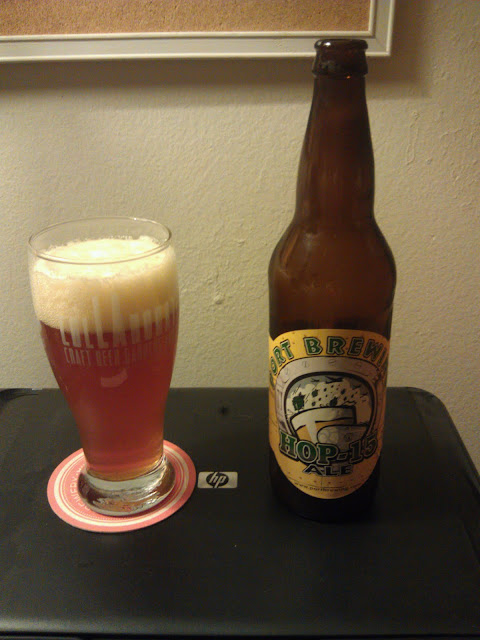As the title says, this is an imperial "black" IPA -- a relatively new term (also sometimes known as "Cascadian Dark Ale" or "India Black Ale") -- to describe a beer with all of the hoppiness of a (double or Imperial) IPA except that it is black in color. Generally, a dark brown or black beer has that color because roasted malts were used in the process of brewing the beer, and those roasted malts have characteristic flavors that are more commonly ascribed to stouts and porters (the traditional "dark" beers.) So, the "black" IPA will have some of the roasted malt character of a dark beer, but those flavors are really supposed to be bit players in the overall taste, leaving the hops dominant. It's a bit of a trendy brewing trick with varied results.
Appearance: As the name suggests, this beer looks like a stout to the unsuspecting eye. It's a deep black in color, with about two fingers of mocha-colored head that leave thick, sticky lacing on the sides of the glass. It's completely opaque, and there is no visible carbonation in the glass.
Smell: The dominant smell is resiny, piny hops. There is a vague hint of a smoky chocolate from the roasted malt, and a less dominant residual hint of acidic fruit from the hops.
Taste: This is a big beer. Hops are predominant, as expected from an imperial IPA, but the roasted malt provides an intriguing and solid backbone to the punchy, piny hops. I've mentioned before that I'm not a huge fan of overmalting an imperial or double IPA to balance it, but roasting the malt is an interesting trick that allows for a strong malt profile without making the beer (to my palate) sickly sweet. I do get a bit of an alcohol bite as the hop characteristics transition to the malt, which is neither unpleasant nor unexpected in a beer as strong as this. One thing that was lost in this hybrid style, for me, are fruity subtleties that can usually be detected in a hop-forward beer. Though I was able to faintly smell some fruit on the nose, perhaps pineapple or grapefruit, the extra bold roasted malt overpowered a bit of the softer characteristics of the hop, leaving behind only the resiny bitterness.
Mouthfeel: The beer was medium bodied, and very appropriately carbonated given the huge taste. At the front of the sip, the carbonation lightens up the beer, contrasting nicely with the huge flavors. Further back in the mouth, the beer is creamy, which gives the contrasting flavors the opportunity to meld on the palate.
Overall: As you can see from the lengthy (or lengthier than usual) description, I found this to be a very unusual and exciting beer. I've only had the opportunity to try two other black IPAs ever, and I've found the three (including this) to be similar; however I think that, despite not doing a detailed profile of it at the time, there was a black IPA offered by Kern River brewing that is probably my favorite, based on memory alone.
If the internet is any indication, there is a bit of contention among beer geeks if this style really deserves to be called its own style. Some feel that there is no reason why there can't be such a thing as a hoppy porter or stout. Though I'm really only a (mediocre) taster and not a beer historian or label expert, it kind of seems to be that this argument is really just a reversal of the current name -- IPA with roasted malt vs. porter/stout with extra hops. If this ends up being a style that grows and isn't merely a trendy brewing idea that dies out within a few years, I don't see any reason why it shouldn't be considered its own style. After all, even within IPAs, there are "American-style" IPAs, "West Coast" IPAs, etc. You get the picture. And the way that styles are today, I wouldn't think that it would be appropriate to just call this an IPA or a porter/stout. It's truly a blend, and as such, deserves its own moniker.
But back to this particular beer. For the time being, I'm going to say I love this. It's easily the most acceptable way that I've had of allowing the malts to have a front-and-center performance in a beer that otherwise showcases hops. I love that the chocolate notes lent by the malt becomes bittersweet chocolate when the hops have had their say. And obviously, I just love hoppy beers in general. I'd love to see with time how this holds up -- if other examples of the style are going to eclipse this in my memory of favorites, or if this is going to remain at the top of the list. As of right now though, all I can say was that for me, this was truly different and great, even if it won't be drinkable for people who don't love hops (because let's face it -- Stone never shies away from hoppy-ass beers, and this is no exception.)
5/5



































